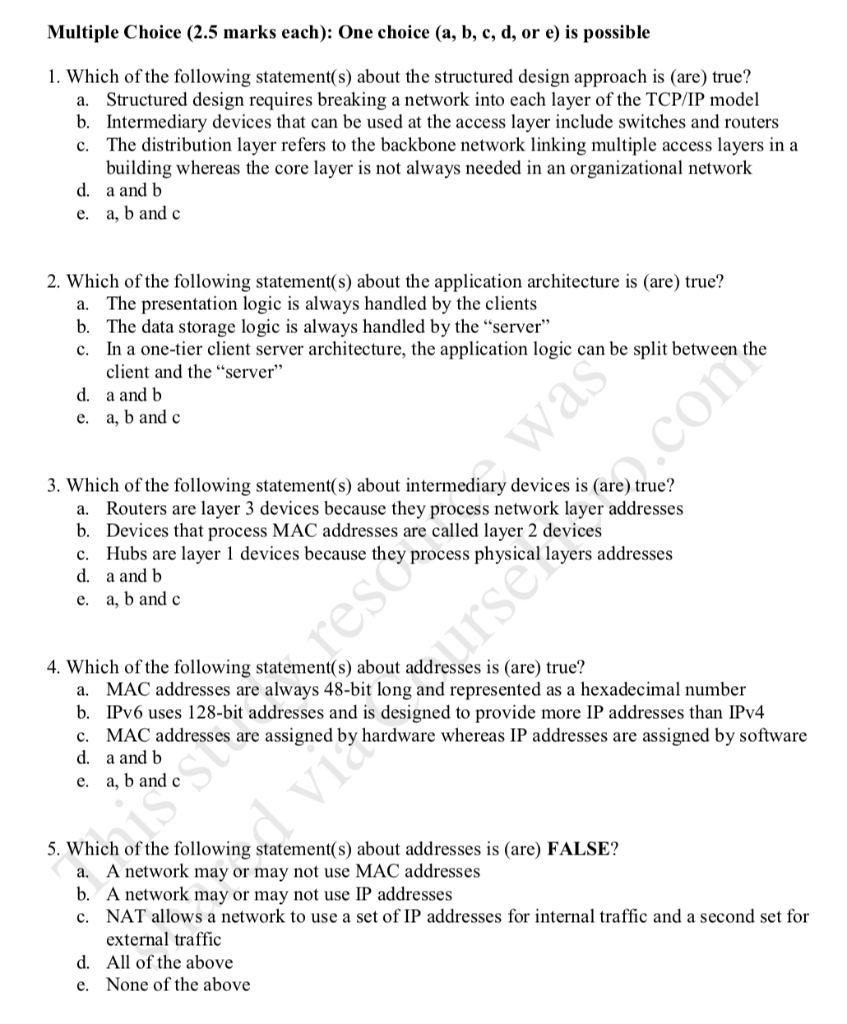

Multiple Choice (2.5 marks each): One choice (a, b, c, d, or e) is possible 1. Which of the following statement(s) about the structured design approach is (are) true? a. Structured design requires breaking a network into each layer of the TCP/IP model b. Intermediary devices that can be used at the access layer include switches and routers c. The distribution layer refers to the backbone network linking multiple access layers in a building whereas the core layer is not always needed in an organizational network d. a and b e. a, b and c 2. Which of the following statement(s) about the application architecture is (are) true? a. The presentation logic is always handled by the clients b. The data storage logic is always handled by the server c. In a one-tier client server architecture, the application logic can be split between the client and the "server" d. a and b e. a, b and c a. 3. Which of the following statement(s) about intermediary devices is (are) true? Routers are layer 3 devices because they process network layer addresses b. Devices that process MAC addresses are called layer 2 devices c. Hubs are layer 1 devices because they process physical layers addresses d. a and b a, b and c veste water e. 4. Which of the following statement(s) about addresses is (are) true? a. MAC addresses are always 48-bit long and represented as a hexadecimal number b. IPv6 uses 128-bit addresses and is designed to provide more IP addresses than IPv4 c. MAC addresses are assigned by hardware whereas IP addresses are assigned by software d. a and b nuo SA e. a, b and 5. Which of the following statement(s) about addresses is (are) FALSE? a. A network may or may not use MAC addresses b. A network may or may not use IP addresses c. NAT allows a network to use a set of IP addresses for internal traffic and a second set for external traffic d. All of the above e. None of the above 6. If you are trying to log onto www.toronto.com, a related DNS response message contains: a. The host name corresponding to www.toronto.com b. The IP address corresponding to www.toronto.com C. The MAC address corresponding to www.toronto.com d. The IP address of the next router on shortest path to the server you are trying to log onto e. None of the above 7. Which of the following statement(s) about the implementation of the forwarding algorithm is (are) FALSE? a. Packets are not sent to the router when the sender and the receiver are in the same subnet but are sent to the router when the sender and the receiver are in different subnets b. At each hop between the sender and the receiver, the information related to the destination MAC address in a packet is changed but the information related to the destination IP address in that packet is not changed c. Routers must send RARP requests before delivering packets to their final destination d. a and b e. a, b and c WA 8. Which of the following statements about network devices is (are) true? a. Devices with high MTBF and low MTTR and managed devices help improve the performance of a network b. Internal routers can be used to move data within LANs and between LANs, whereas default gateways can be used to connect organizational networks to the Internet c. Types of cables commonly used in today's networks include coaxial cables, twisted pair cables and fiber optic cables d. All of the above e. None of the above 9. Which of the following statement(s) about routing is (are) true? a. Metrics used for dynamic routing decisions can include cost, capacity, traffic conditions and number of hops b. Dynamic routing is based on dynamic addresses whereas static routing is based on static addresses c. Link State algorithm uses one metric for routing whereas Distance Vector can use multiple metrics d. a and b e. a, b and c 10. Which of the following statement(s) about the OSI model is (are) true? a. From top to bottom, the 7 layers of the OSI model are the application, the presentation, the session, the transport, the network, the data link and the physical layer b. Together, the top 3 layers of the OSI model perform the same functions as Layer 5 of the TCP/IP model c. In the OSI model, the application layer handles the transfer of data between applications while the presentation layer handles the segmentation of the message d. a and b e. a, b and c








